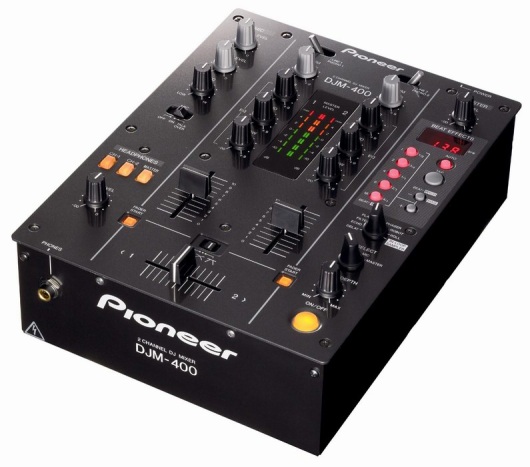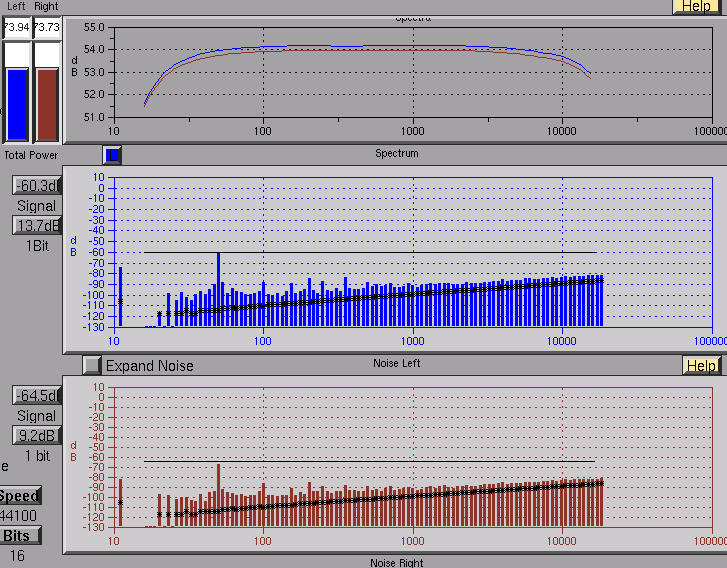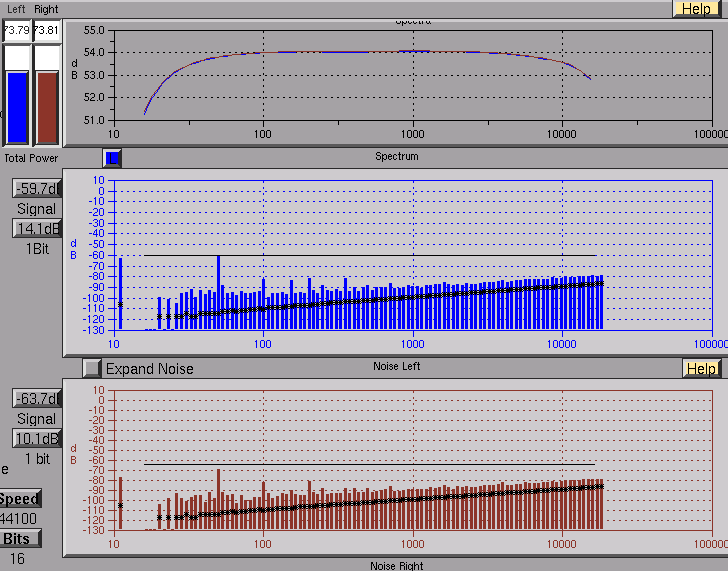
Chris Close
christopher dot close at g mail dot com

After testing my DJM-300 previously, I thought it would be good to compare the results with my new Pioneer DJM-400 mixer.
The M-Audio Transit USB sound card:  will be used for the testing once again.
will be used for the testing once again.
DISCLAIMER: I don't assert that these tests are 'real world' results. I mostly did this to ascertain where the EQs cut in on this mixer. Don't take the response and noise values as gospel.
While this card is capable of doing 96kHz/24bit, I performed these tests in 44.1kHz/16bit mode. It would have been possible to do the tests in 48kHz/24bit if I was to find the correct test file for the xsndtest program, however the site was down. Full-duplex 96kHz operation is not supported by the device.
The program I used to perform the tests is xsndtest. This program runs under Linux.
The result below is from looping the Line Output from the sound card directly back to the Line Input of the sound card (used a standard 3.5mm stereo cable). I had to adjust the playback/recording levels appropriately in the software mixer for the sound card in order to get the best results:

The card gives pretty good results on its own. I noticed this time that if I put the cable near the powered on DJM-400 there is no extra noise. The DJM-300 on the other hand would add some extra noise.
The graphs shown are in a logarithmic scale. For your reference:
The notch inbetween 10 and 100Hz on the spectrum is 31.6Hz.
The notch inbetween 100 and 1000Hz on the spectrum is 316Hz.
The notch inbetween 1000 and 10000Hz on the spectrum is 3162Hz.
The next set of results are from sending the Line Output from the sound card into the 'Line 2' channel on the mixer (using a stereo 3.5mm -> 2 x RCA cable). One of the main outputs from the mixer is then sent to the Line Input on the sound card. I had to adjust the recording levels appropriately in the software mixer for the sound card in order to get the best results. The 'Master Volume' was set to about 3 o'clock this time around. This results in the output meter on the mixer showing a volume of about 2dB (the first orange light).
Here is the result of the test with Channel 2 fader up 100%, Channel 2 at 0%, the cross-fader disabled and the EQ's all at 12 o'clock:

The frequency response is very similar to the DJM-300, but with less noise. I'm not a sound technician, but it looks quite good. An extra 10-14dB of noise seems to have been added to the circuit compared to the Transit on its own. (The DJM-300 added 15-18dB of noise.) The output level graph at the top shows the signal flattening out to around 54dB. We will be using this as the base for the rest of our tests.
You might notice a (relative) peak of distortion at around 50Hz (sounds like electricity ;) ). That peak was not there with the DJM-300, but the overall noise is less anyway.
For the following tests I have omitted the noise statistics. I noticed that there was no massive difference in the amount of noise produced by the unit depending on the EQ settings.

The cut starts to work up to around the 316Hz mark. At 100Hz there is approx 36dB attenuation. At around 56Hz there is approx 64dB attenuation. At 31Hz there is close to 80dB attenuation.

I'm guessing about 22dB attenuation at 100Hz. It seems to be relatively flat until there.

I've included the 'flat' response for comparison.

For anyone crazy enough to be turning up their bass this far, an amplification of around 5dB seems to be present up to around 170Hz.

You can see the bottom of the drop at approx 1148Hz. Looks to be about 45dB attenuation.

Looks to be about 26dB attenuation compared to the flat response at approx 1130Hz. Unlike the previous test on the DJM-300, the bass response has not been altered.

I've included the 'flat' response for comparison.

The middle of the peak looks to actually be at 1000Hz this time. About 6dB amplification.

You can see the bottom of the drop where the response cuts off, at around 15000Hz. At this point, we have approx 46dB attenuation. At 10000Hz, we have 29dB attenuation.

Looks to be about 30dB attenuation compared to the flat response at 15000Hz. At 10000Hz, we have approx 24dB attenuation.

I've included the 'flat' response for comparison.

The middle of the peak is at 10000Hz. We have about approx 5dB amplification here.

Basically nothing is heard. The loudest signal has been attenuated by 66dB. What you see here is probably background noise. This graph looks much better than the slippery-dip of the DJM-300 with the same settings.

This shows what happens if we try and cut all the MID + HI frequencies, leaving only the bass. We basically have the full response up to approx 200Hz. At 1000Hz we have 42dB attenuation. At 10000Hz we have 76dB attenuation.

Here 1000Hz gets about 32dB attenuation, while 10000Hz gets 64dB attenuation.
Note: I adjusted the 'Trim' such that the signal would not distort.

What's really interesting here is the fact that cranking your EQs up all the way will not distort your signal so long as you don't overload the output.
It looks like the 'isolator' EQs on this mixer perform quite well. There are no 'holes' inbetween the EQ ranges, as there was with the DJM-300.
Once again, I don't make any claims on this page as to the performance of the mixer. There are a large number of variables involved, including the quality of the cabling and (consumer grade) computer sound equipment.